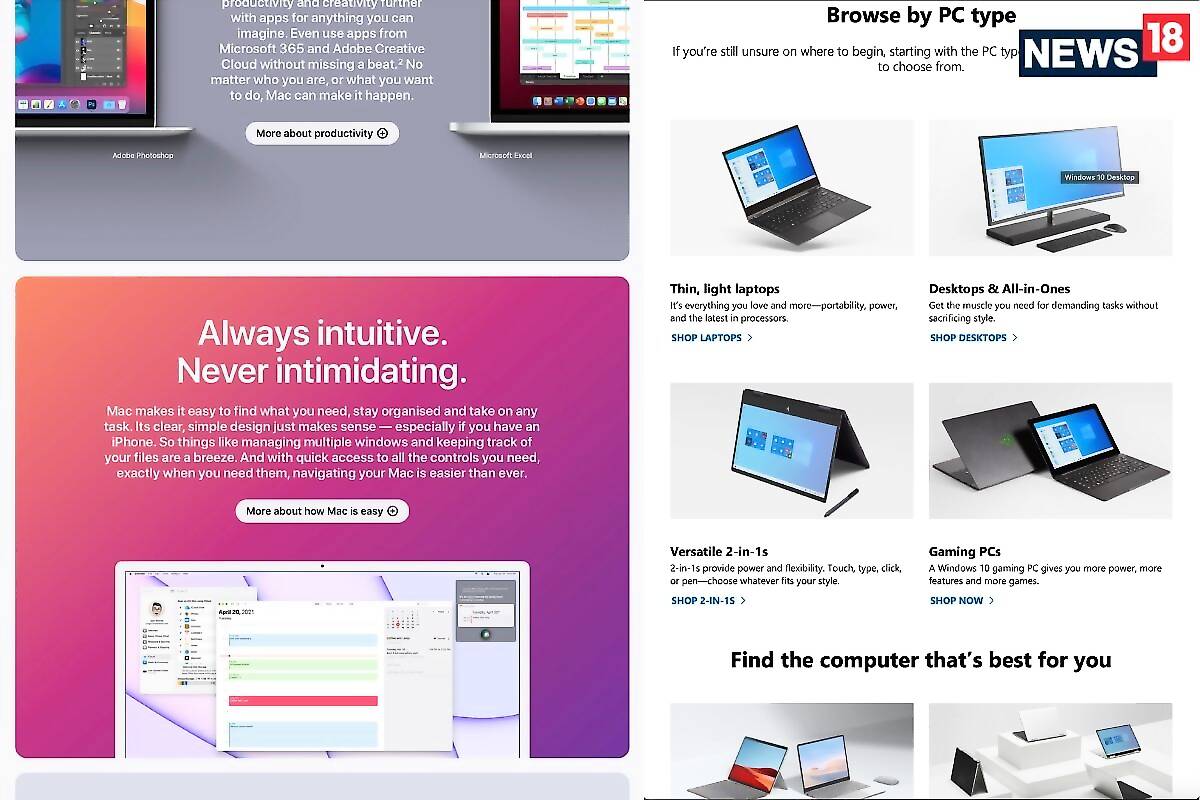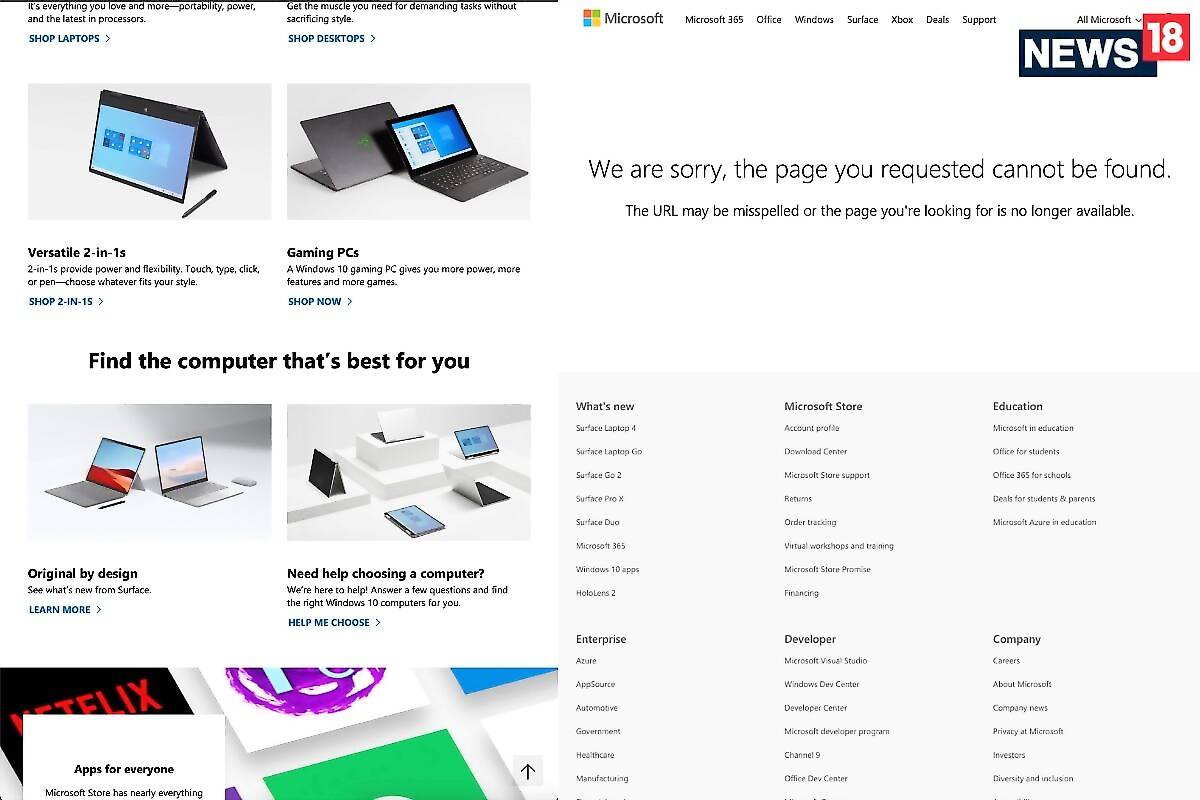Microsoft Tried To Sell Me A PC And Apple Tried To Sell Me A Mac, And The Pitches Are Very Different

views
Why Mac. Find A PC That Fits. Two very different product lines. Two very different demographics. Two appreciably very different experiences. It is often assumed that most buyers know what they want when searching for a new computing device. And they know which camp they are in—Windows or Mac. Yet, things aren’t as simple, and as someone who often has to answer the queries of friends and relatives about which “computer” they should buy, it is safe to say that no such preset clarity is on display. At all. Which makes it even more important for Apple and Microsoft to pitch their platforms and machines, just right. Duly enough, Apple has the “Why Mac” page while Microsoft has something titled “Find a PC that fits”.
Stakes are high. Particularly if both tech giants want to convince the large demographic of the as-yet-undecided potential buyers to become their customers and be part of the fold of apps and services that come with it. Apple has the largest as yet line-up of MacBook portables as well as Mac computing devices, while Windows not only has its own Surface computing devices to put forward, but also a wide variety of form factors as well as machines from brands across multiple price points. This may perhaps be most critical for the Surface portfolio too, considering how over time they have grown up with price tags that now pretty much sit in the same range as the Apple MacBook family. That means all the more convincing power may be needed.
Why Mac: Let us first look at what Apple has for us on the Why Mac page. Yes, that is exactly how the page starts off, gently inviting you to the answer to the question—Why Mac. The messaging is very clear and very simple from the outset. “And designed to let you work, play, and create in ways you never imagined. It’s the computer that comes packed with apps that are ready to go right out of the box,” is part of the opening pitch. Step by step, Apple tackles what you may as questions—how to set up a new Mac if you do buy one, what about productivity apps that you’ll need (Microsoft apps are also referenced), privacy and security and continuity with other Apple devices that you may add to the ecosystem soon. Each has details if you wish to go deeper. In the midst of this, what stands a topic that may as well dispel a lot of myths—Always intuitive. Never intimidating. It talks about how to use Mission Control for multitasking, the Control Center, Siri virtual assistant and document management. If I had a rupee for every time I heard “but Macs are more complicated than Windows” over the years, I’d be able to buy a top-of-the-line spec-ed out variant of the new iMac 24.

The fact that Apple takes cognizance of these real-world questions, would ideally make customers who are still on the fence, a bit more at ease. It tries to bring in real-world illustrations from time to time, and one of those says, “if you already have an iPhone, it feels familiar from the moment you turn it on.” The iPhone is perhaps the most powerful tool in Apple’s product arsenal and to get it in as a reference point for the Mac should be a trump card. There’s more for Apple and Education, Businesses, Parental Controls and Family Sharing, and that’s just Apple flexing the muscles of versatility of what Macs and macOS can do. Apple does not shy away from pitching the ecosystem of apps, services and indeed devices—for some, this is a symbol of being trapped, but for the rest who simply need to get things done, perhaps a bit of a relief. After the software, usability and features are taken care of, there’s the simple yet million-dollar question that is tackled next—Which Mac is right for you? Here, you compare all models, including the MacBook Air and the MacBook Pro series, as well as the iMac and the Mac Mini. Prices at a glance, so you immediately know what’s in your budget range, and then you go to specific product listings to further customize and buy or compare. Ties in with the Apple India Online Store and you can customize and order right there, without leaving the website or having to go to another online store.
Find a PC that fits: So, what does Microsoft do in response? It does have the responsibility of carrying partners along too, including HP, Lenovo, Acer and Asus, to name a few. Subjectivity aside, you will mostly feel that Microsoft approaches this in a very different fashion. There doesn’t seem to be a welcome hand walking you through a maze to the rightful conclusion. It mostly seems dry. Though it tackles mostly what Microsoft believes Windows 10 users need. But I am most certainly perplexed that as soon as it dives into ‘Discover the benefits of a new PC’ (very important topic to tackle up front), the very first point that is raised reads (and I’m not kidding)—” When it comes to a PC with an SSD vs. one with an HDD, some things are just better.” Really! Is it some sort of a test for the reader’s geekery quotient? I can bet everything I own that if I were to redirect most of my relatives and some of my friends to this page and they land up on this SSD vs. HDD gibberish even before having to scroll once on the webpage, they’ll simply close it and return to our one-on-one conversation in a bit of a mood. And a slightly dialed down trust level.
Let us assume that this page is for those who need to buy a laptop or a PC and are confused or at least undecided. Is it really the best thing to welcome them with some matter to fact statements and some complex specification terminology? Scroll down a bit and much to my horror, I realized that the entire SSD vs HDD saga continues—SSDs are 4x faster on average than HDDs, Windows Updates install 3x faster with SSD and more. The page then opens up into ‘Get started with PC hardware basics’ section. This is where Microsoft has so much to talk about and the approach they take is more of a Q&A format, and to be fair, answers the most important questions any first time PC buyer would want answers for—what is a SSD (again!), what is a CPU, what is RAM and more. And this is where Microsoft approaches its strongest suite.
The ‘Browse by PC type’ section illustrates the various form factors that Windows 10 PCs can be had in. Thin and light laptops, convertibles and 2-in-1s, gaming PCs and desktops as well as all-in-ones (AIO). Each section helpfully has a Shop link but at the time of writing this, clicking on all four of these shop options took us to a page that holds a rather disappointing message which reads, “We are sorry, the page you requested cannot be found” (this may be a temporary issue, hard to comment on whether it is a perpetual dead end). We return to the original point in the journey and scroll down a bit more. This brings us to the doorstep of something called ‘Find the computer that’s best for you’. But hang on, there is no shop button here. Wait, what! Two sections, one which says, ‘See what’s new from Surface’ and ‘Need help choosing a computer?’ The Help Me Choose option for the latter leads to a path that doesn’t hold any information while the Microsoft Surface page tells us more about the Surface Laptop Go, Surface Go 2, Surface Book 3, Surface Pro X, Surface Laptop 4 and the Surface Pro 7. But if you want to buy, Microsoft will helpfully redirect you to Amazon.in and Reliance Digital online shopping platforms to search and purchase.

What’ll You Buy? The answer may be more resounding than you may have imagined. But may perhaps grudgingly agree with. From the way Apple and Microsoft try to show you around, explain what’s what and run you through the options you can purchase from, there is something definitely more convincing about how Apple does things. And all these years of hearing that Windows is simpler than Macs and yet ending up with SSD vs. HDD descriptions and broken buying guide links, it all seems very ironic. To be honest, PC makers such as HP do a better job with their own implementation of ‘What can we help you find? Find the Printer or PC that’s right for you’, compared with what Microsoft manages. Is it that this is just Microsoft’s personality? A bit like how contrasting it is to watch interviews of Sebastian Vettel and Kimi Raikkonen? Vettel is more Apple, descriptive, elaborate and sneaks in a laugh once in a while? Microsoft is more Raikkonen, matter to fact, minimal words and letting you make up your own mind? That may be a fine strategy to have, but from what I know of my friends and relatives, they’ll not be able to make up their minds. For any Windows 10 PCs.
Read all the Latest News, Breaking News and Coronavirus News here.




















Comments
0 comment